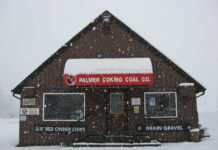Two of the most important figures in the early years of coal mining in Washington were brothers, both immigrants from Denmark. This portrait of a young James Anderson is exhibited at the Black Diamond Museum. Born in Ringkobing, Denmark on March 29, 1856, Jim as he was affectionately known, came to the U.S. at age 30 following training and receipt of his engineering degree from the University of Copenhagen. For three years he engaged in mining in Illinois and Colorado before coming to Washington in 1889. Around 1894, Anderson began a career with Pacific Coast Coal Co., and soon rose to the position of chief engineer.
A few years later he was responsible for the purchase of mines in Black Diamond and Burnett, and also instrumental in construction of railroad, bridge, and dock facilities of the parent firm, Pacific Coast Company. In recognition of Anderson’s abilities he was appointed by Governor Hay to a 1911 commission, that drew up Washington’s first Workmen’s Compensation Act. That effort was a testimony to his desire to improve living and working conditions of mine employees and their families. After his death in March 1914 at age 58, all the mines of Pacific Coast Coal were closed that Monday in respect so company employees could attend his funeral.
His brother, C.C. Anderson was similarly educated and rose to prominence, eventually becoming General Manager of Northwest Improvement Company, a division of the Northern Pacific Railroad. For a short time before Jim’s untimely death, the brothers held top positions at the two largest coal mining companies in the state. This photo of his portrait was taken by Robert Dobson of Kent and comes courtesy of the Black Diamond Historical Society.






